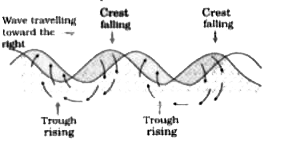How do you demonstrate the hello crests and troughs in a slinky?
1) Hang a slinky from a fixed support.
2) Hold it gently at the lower end and quickly move your hand sideways and back.
3) This will cause a hump on the slinky near the lower end.
4) The hump travels upwards on the slinky as shown in the figure.
5) The humps formed alternately are known as crests and troughs.

Topper's Solved these Questions
- SOUNDBOOK - VGS PUBLICATION-BRILLIANTCHAPTER - SOUNDEXERCISE - THINK & DISCUSS
13 Videos
- SOUNDBOOK - VGS PUBLICATION-BRILLIANTCHAPTER - SOUNDEXERCISE - QUESTIONS GIVEN IN THE LESSON
21 Videos
- SOUNDBOOK - VGS PUBLICATION-BRILLIANTCHAPTER - SOUNDEXERCISE - TRY THESE
7 Videos
- REFLECTION OF LIGHT AT CURVED SURFACESBOOK - VGS PUBLICATION-BRILLIANTCHAPTER - REFLECTION OF LIGHT AT CURVED SURFACESEXERCISE - EXERCISE
66 Videos
- SYSTEM OF PARTICLES AND ROTATIONAL MOTION BOOK - VGS PUBLICATION-BRILLIANTCHAPTER - SYSTEM OF PARTICLES AND ROTATIONAL MOTION EXERCISE - PROBLEMS
17 Videos
Similar Questions
Knowledge Check
A source of wave produces 20 crests and 20 throughs in 0.2 s. Find the frequency of the wave.
A200 HzB500 HzC100 HzD300 HzWhat is the distance between a crest and a consecutive trough in a transverse wave ?
AWavelenghtBAmplitudeCHalf of the wavelengthDTwice of wavelength
How will you demonstrate that water vapour is present in air ?
View SolutionStudy the diagram given below and answer the questions that follow:

(i) What do you understand by waves?
(ii) What are crest and trough?
(iii) Why do waver travel?
View SolutionHow will you demonstrate that interparticle spaces are present in a matter ?
View SolutionHow will your demonstrate that the ionic compounds do not conduct electricity in the solid state and can do so in solution.
View SolutionConsider Experiment 2, Art. 4(a). 3,
(a) What would you do to obtain a large deflection of the galvanometer ?
(b) How would you demonstrate the presence of an induced current in the absence of a galvanmeter ?
View SolutionDescribe how you could demonstrate that white light is composed of a number of colours.
View Solution
